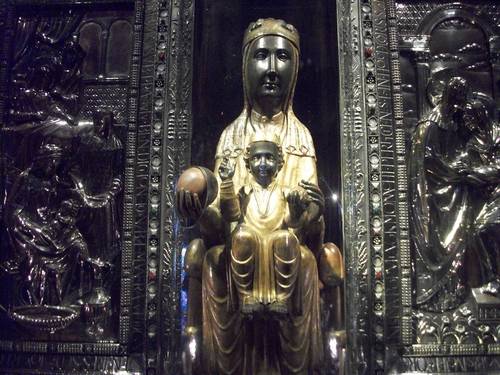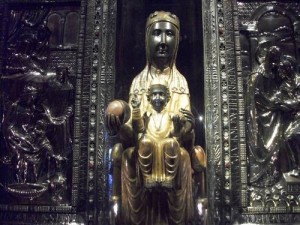
HAPPY HUMP DAY, P.O.U.!
We continue our series The Black Madonna & Child II
THE BLACK VIRGIN OF MONTSERRAT
Catalonia, Spain
(From La Moreneta – The Black Virgin Story)
…According to legend La Moreneta was carved by St. Luke and brought to Montserrat by St. Peter in 50 AD, then hidden from the moors in the Santa Cova (holy cave) just down the mountain from the monastery. By the late 1100s, a new wooden sculpture of the miraculous image was made, and it is this Romanesque statue that pilgrims are familiar with today. In 1522, St. Ignatius of Loyola came in pilgrimage, and made the decision to abandon his former life as a warrior, leaving his sword as an offering to Our Lady of Montserrat and settling for some time in the nearby town of Manresa as he discerned his vacation and wrote his Spiritual Exercises. The old church was replaced with an enormous transitional late Gothic/Renaissance-style basilica in 1592, and this building stood until much of it was destroyed by the armies of a retreating Napoleon in 1811. Fortunately, the monks managed to hide the image of Our Lady of Montserrat so that it was not destroyed along with the rest of the abbey. In 1880, Our Lady of Montserrat was officially declared to be Patroness of Catalonia by Leo XIII. In more recent times, Pope John Paul II came to Montserrat on pilgrimage in 1982, to pray before the image of the Black Madonna…
On a rugged carved mountain not far from Barcelona lies one of the most popular destinations of the Catalan region and Spain: the statue of the Black Madonna. According to the legend, the statue was discovered in the year 880 by some shepherds who have seen a strange light on the sky and heard music coming from a cave in the mountain. From that moment on the statue remained on the Montserrat mountain becoming one of the most famous pilgrimage sights in Spain.
The statue became more and more famous after people started reporting miracles and attributing it mystical healing powers. In 1881 the Montserrat Madonna was crowned in accordance with Canon Law and proclaimed patron saint of Catalonia by Pope Leo XIII. Its fame still attracts flocks of pilgrims who come to the sacred mountain either to take part at the monks’ daily celebrations of Mass and recitations of the Liturgy of the Hours either to visit the Basilica, next to the monastery, to see La Moreneta.

